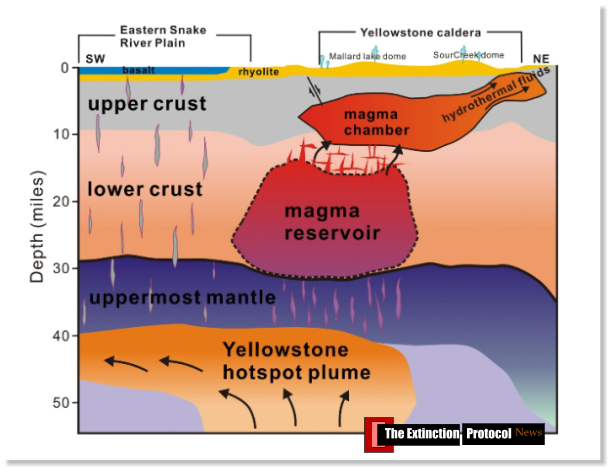Skip to main content
Monster: Scientists find missing link in Yellowstone plumbing- supervolcano contains enough magma to fill the Grand Canyon

April 2015 – YELLOWSTONE – Yellowstone National Park is the home of one of the world’s largest volcanoes, one that is quiescent for the moment but is capable of erupting with catastrophic violence at a scale never before witnessed by human beings. In a big eruption, Yellowstone would eject 1,000 times as much material as the 1980 Mount St. Helens eruption. This would be a disaster felt on a global scale, which is why scientists are looking at this thing closely. On Thursday, a team from the University of Utah published a study, in the journal Science that for the first time offers a complete diagram of the plumbing of the Yellowstone volcanic system.
The new report fills in a missing link of the system. It describes a large reservoir of hot rock, mostly solid but with some melted rock in the mix, that lies beneath a shallow, already-documented magma chamber. The newly discovered reservoir is 4.5 times larger than the chamber above it. There’s enough magma there to fill the Grand Canyon. The reservoir is on top of a long plume of magma that emerges from deep within the Earth’s mantle. This system has been in place for roughly 17 million years, with the main change being the movement of the North American tectonic plate, creeping at the rate of roughly an inch a year toward the southwest. A trail of remnant calderas can be detected across Idaho, Oregon and Nevada, looking like a string of beads, marking the migration of the tectonic plate. A similar phenomenon is seen in the Hawaiian Islands as the Pacific plate moves over a hot spot, stringing out volcanoes, old to new, dormant to active.
“This is like a giant conduit. It starts down at 1,000 kilometers. It’s a pipe that starts down in the Earth,” said Robert Smith, emeritus professor of geophysics at the University of Utah and a co-author of the new paper. The lead author is his colleague Hsin-Hua Huang. This new picture doesn’t change, fundamentally, the risk assessment of Yellowstone, but it will help scientists understand the mechanics of the volcano. Risk assessment is tricky for low-probability, high-consequence events like volcanic eruptions. The big Yellowstone eruptions occur on time scales of many hundreds of thousands of years. Smith said the repeat time for a caldera explosion at Yellowstone is roughly 700,000 years. But the smaller eruptions, with lava flowing over the surface, are more frequent. There have been at least 50 such smaller eruptions since the caldera exploded 640,000 years ago. The most recent was about 70,000 years ago.
This is a volcano that can erupt either in a big way or a truly colossal and catastrophic way. The big eruptions can send lava flowing over a big portion of the park; the really huge ones can form a giant crater, or caldera. The last time Yellowstone had a calderic eruption was 640,000 years ago, and the misshapen hole it created was about 25 miles by 37 miles across. Geological processes don’t follow clocks. These are chaotic systems, with strain building unpredictably as distant faults break and the geological stresses shift here and there. Bottom line: Yellowstone is unpredictable. There’s no sign at all that this old volcano is going to erupt anytime soon, either in a big way or a huge, show-stopper way. But neither is there any evidence that it’s running out of steam. –Washington Post


Comments
Post a Comment